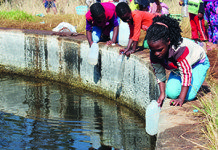
[miningmx.com] – HISTORICALLY environmental authorisation for mining activities required the involvement of at least three state departments: the departments of mineral resources, environmental affairs and water and sanitation.
The drawn out process of granting environmental authorisation and water licences caused substantial delays in prospecting and mining, which in turn had a negative impact on mining companies funding and finances.
The introduction of the One Environmental Management System in December 2014 is, in theory, a positive step that will speed up authorisations and bring about much needed coordination among the different departments.
Under the new system, the Department of Mineral Resources (DMR) will be the issuing authority for environmental authorisations and waste management licences in accordance with the National Environmental Management Act (Nema) and the National Environmental Management Waste Act.
The minister of environmental affairs, on the other hand, will act as the appealing body for these authorisations, while the department of water and sanitation will still be responsible for issuing water licences.
Whereas the application processes followed one another, they will now run concurrently under the new system and the DMR has undertaken that the new turnaround time for all three authorisations will be 300 days.
There are doubts about government’s ability to meet the significantly shorter turnaround times, though.
Water licences, in particular, take exceptionally long to be issued – anything from six months to six years – and a number of mining companies have operated without the necessary authorisation and continue to do so.
The One Environmental Management System means less inter-governmental cooperation since the DMR now deals with environmental applications, said Carlyn Frittelli Davies and Lloyd Christie, directors in the mining and environmental departments at ENSafrica. “From an administrative perspective it’s better because the various applications are submitted to one department.’
Environmental lobby groups, such as the Centre of Environmental Rights, on the other hand, are concerned about the quality of the licences that will be issued by the DMR because of the shorter timeframe.
But Warren Beech, head of mining and partner at Hogan Lovells, said that it is improbable that the quality of environmental authorisations will be in jeopardy as a result of the One Environmental Management System.
Compliance requirements, he said, remain in place and these stringent criteria are unlikely to be compromised. If anything the process should be more efficient.
ENSafrica agreed: “It does not necessarily mean that environmental authorisations will be merely a rubber stamp on the way to the grant of a mining right or prospecting right just because the DMR is now the competent authority”.
Concerns from environmental groups that the DMR will be both ‘player’ and ‘referee’ with regard to environmental compliance aspects, are therefore unfounded. “I believe the DMR is the appropriate authority to deal with environmental compliance,’ said Beech.
“The DMR understands prospecting, mining and the applicable legislation, including the overarching the Mineral and Petroleum Resources Development Act (MPRDA), as well as the potential environmental harm and the rehabilitation that must be carried out by the mining industry in particular.’
Furthermore, there are sufficient checks and balances in that the minister of environmental affairs is the appeal authority for environmental authorisations, says ENSafrica.
PROGRESS
DESPITE doubts in the industry, the DMR believes that it will be able to meet the new timeframes and that it has sufficient capacity to deal with environmental authorisations.
“When we announced the One Environmental System in December we were confident that we were ready to implement it. We haven’t received any negative reaction from applicants for prospecting or mining rights since then,’ says Phuti Mabelebele, DMR spokesperson.
The department is in the process of appointing 28 environmental mineral resource inspectors to process applications for environmental authorisations and waste management licences. “These inspectors are required to undergo training which is offered by the University of Pretoria,’ Mabelebele says.
But training takes time and could cause potential delays in the process of applications for environmentally related authorisations.
“Capacity is often an issue for government departments and it seems the DMR is aware of this and therefore upskilling officials,’ says ENSafrica. “But only time will tell whether the DMR’s efforts have been enough to meet the 300-day turnaround time.’
The DMR is also closely cooperating with the department of water and sanitation to address backlogs with water licences. “The ministers of environmental affairs, mineral resources and water and sanitation agreed on fixed timeframes for the issuing of these permits in their respective legislations,’ Mabelebele adds.
But ENSafrica’s Frittelli Davies and Christie say that the “outlier’ is still the application for a water licence, and Beech concurs.
“Water licence applications remain a concern,’ he says. “The department of water and sanitation has indeed committed to the speedier processing of water use licence applications, and there has been successes, but the process is still lengthy and typically, the water licence often delays the commencement of prospecting and mining.’
Water licences are not the only cause of concern as far as the One Environmental System is concerned. The verdict is still out on when regulations with regard to mineral waste, which previously resorted under the MPRDA, will be finalised.
With the introduction of the One Environmental Management System, mineral waste management was moved to the National Environmental Management Waste Act (Nemwa), which stipulates that mines will in future need a waste licence to dispose of residue.
According to a Moneyweb report, the revised Nemwa defines mineral waste as hazardous, which means the sites that mining companies use to dispose of waste will have to meet the same requirements of small landfills. This could cost the industry millions of rand.
The Nemwa regulations, however, are still pending, and mineral waste in the meantime continues to fall under the MPRDA. As soon as regulations have been promulgated it will mean mining companies will have to comply with an additional set of protocols.











